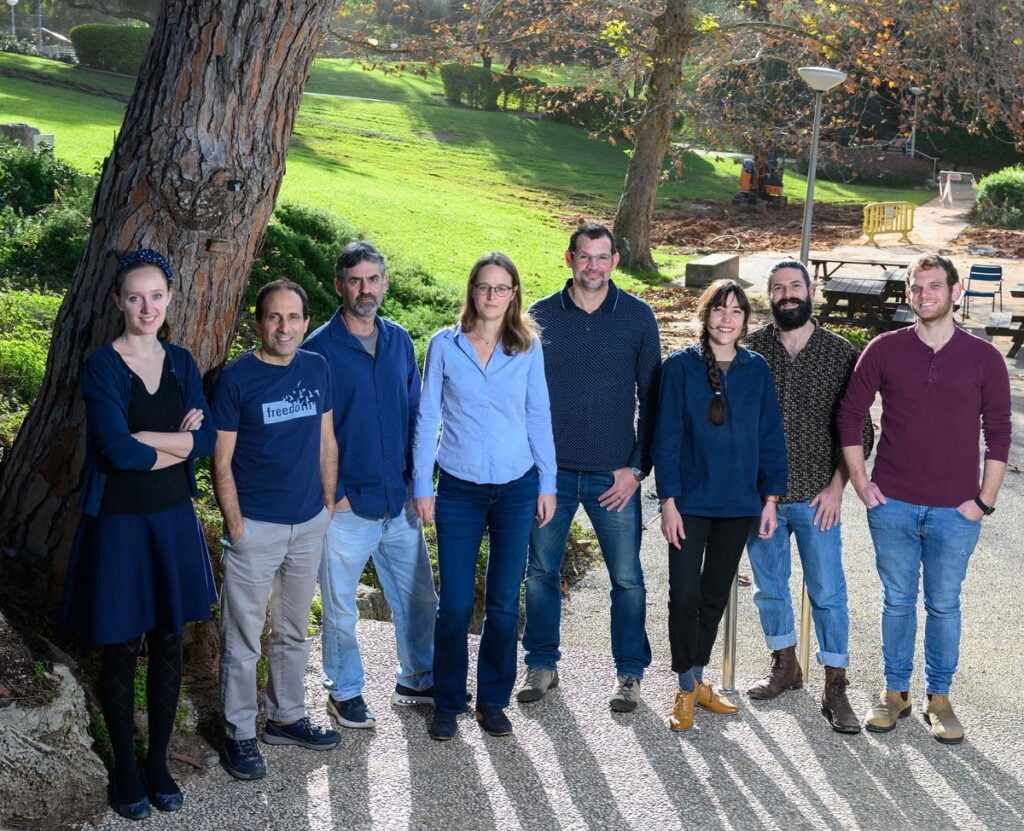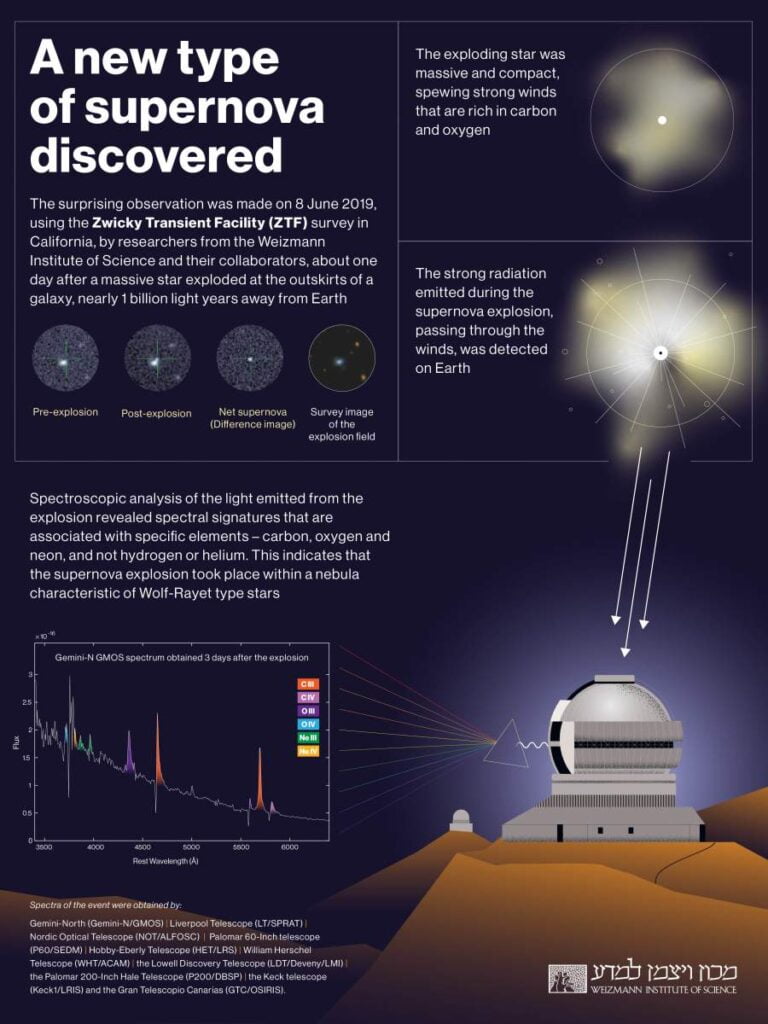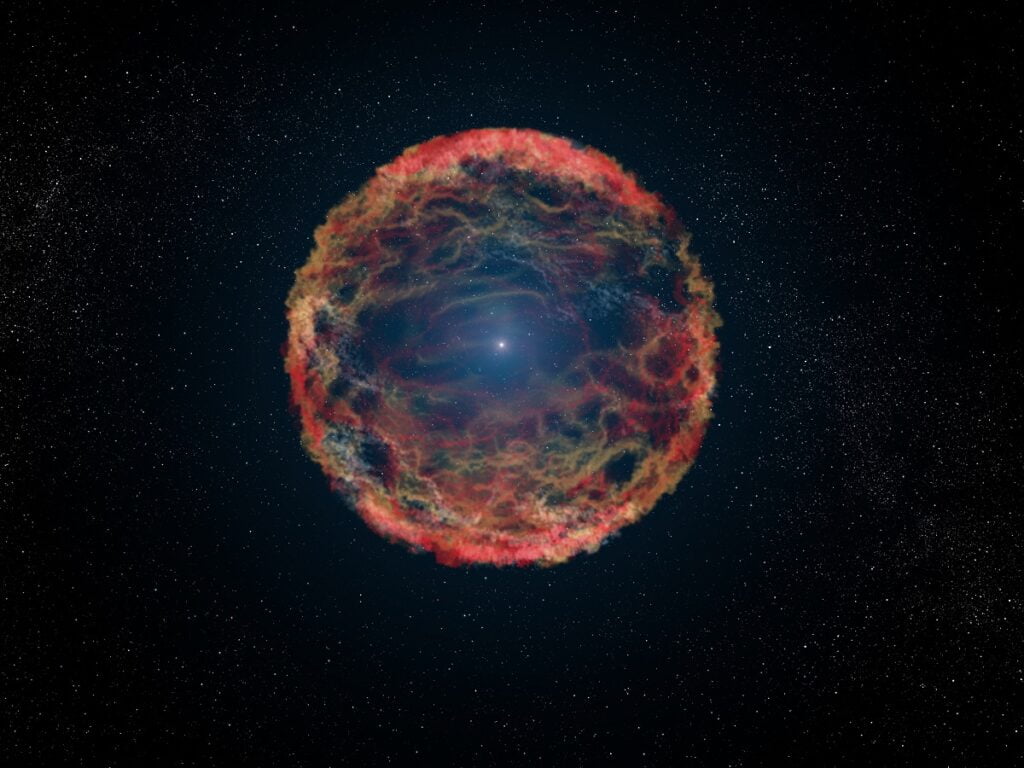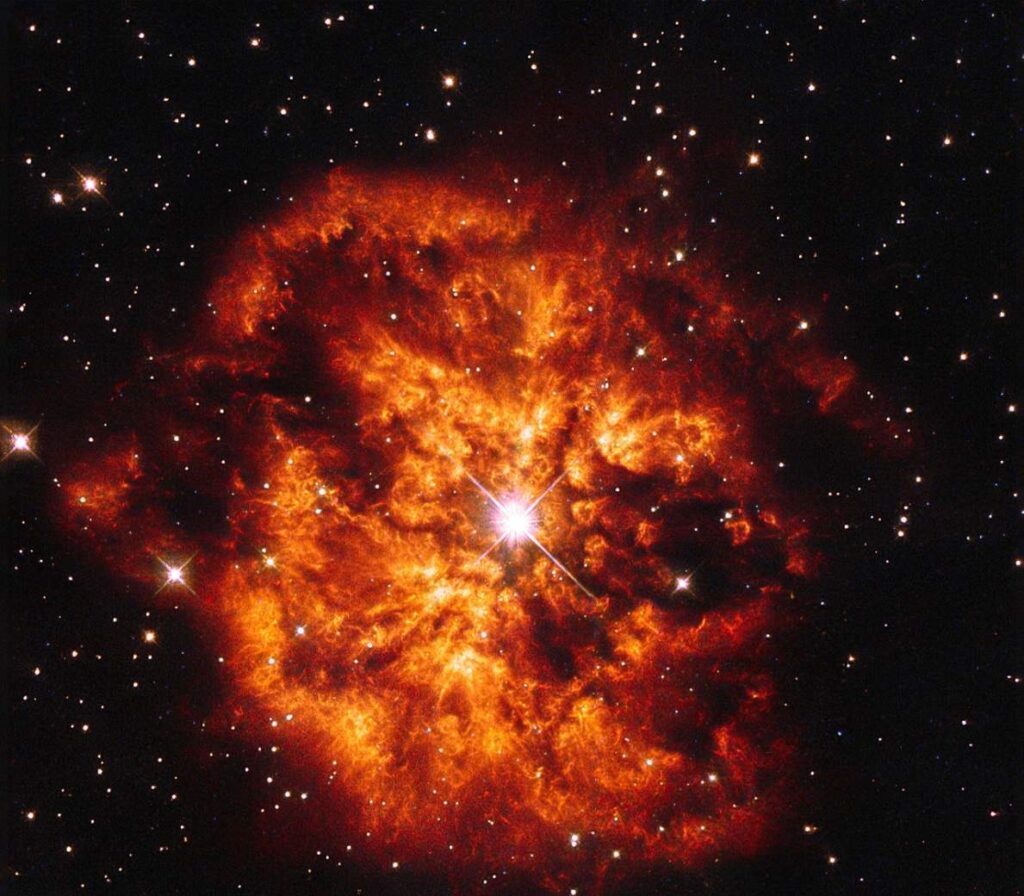It was on a Saturday that PhD student Rachel Bruch’s world changed. The 27-year old astrophysics student was on a scanning shift looking through night sky pictures when she noticed a strange occurrence.
“When I first saw it, I thought, ‘Okay, I have this intuition and feeling that this is something that we have never seen before,” Bruch tells NoCamels in an interview.
Her intuition was right, and the discovery has gone on to wow the world community.
Bruch, together with a team of researchers at the Weizmann Institute of Science – and led by Professor Avishay Gal-Yam – found a new supernova and disproved a long-held theory. Their findings were published in the scientific journal Nature last month.

“Our initial data revealed a hitherto unobserved rich set of emission lines that persist shows that these arise from a nebula composed of carbon, oxygen, and neon, with no obvious trace of hydrogen or helium…We could find no similar spectra among thousands of previously reported observations of explosive transients,” the authors wrote in their findings.
Stars are like living organisms, and diverse as they are, they all suffer at some point or another a common fate: they die, or, more precisely, the nuclear fusion within their core that keeps the gravitational force from pressing onto them stops and they either collapse onto themselves and become black holes, or they explode and become a supernova.
Interest in supernovae is high because these stars are more than just galactic atomic bombs; they can create life in the universe.
“More than 90 percent of the universe is made of hydrogen, maybe a little bit of helium. But we are composed of all of this carbon and oxygen and all other kinds of elements. Where did that come from?” says Bruch.
The fusion within the stars creates elements heavier than hydrogen and the supernova explosion spreads them throughout the universe. “So without supernovae, there wouldn’t be life,” says Bruch.

Supernovae, when observed in the early 1930s, were thought to be rare occurrences. But today, through advanced technologies, it is known that there is at least one supernova every day somewhere in a galaxy.
“We’re always seeing astronomy with these huge timescales, like, hundreds of light years away. But no, because a supernova explodes within a few minutes, and then the lights [of the explosion] come up in a few hours, to detect them you actually have to be quick because otherwise, you will miss them,” says Bruch.
That Saturday, when Bruch was in the lab, she was going through the pictures of certain fields of the sky taken with the help of the California-based Zwicky Transient Facility’s powerful 48 to 200-inch telescopes.
“We can have this dynamic mapping of the sky. Meaning, if there’s something new popping up, we can know it within a few hours; you know, you take a picture, then you take another picture, then you do the subtraction of both, and then you see ‘oh’ there is a new point that appeared,” says Bruch.
Upon seeing what she thought she saw, Bruch decided to ask her peers to corroborate her findings.
“I sent it to a few colleagues asking ‘Don’t you think it’s a bit weird? I’m not sure I’ve ever seen this before.’ And then one of the postdocs at the time came and said ‘Rachel, it’s insane! We’ve never seen this before! It’s absolutely insane!’ And for the next five days I was just in front of my computer, and just waiting for new data to come in.”
“And then a few months in and we find that indeed it doesn’t correspond to anything ever seen before. So it’s very exciting. It’s incredible. To experience this in my first PhD year,” says Bruch.
It wasn’t just Bruch and her lab mates who got excited. The global astronomy community has been taking notice, too.
“BOOM! A New Kind of Supernova Has Been Discovered,” reads a headline for SciTech Daily.
A sky full of stars
After all, a twinkling star observed with a pair of simple goggles from Earth looks like any other shining round object that sprinkles the night sky.
It is only when observed with the right tools that stars reveal their full natural diversity. They come in all kinds of sizes, small like our sun, or millions of kilometers in width like the Betelgeuse red supergiant. They also vary in mass (some heavier, some lighter), luminosity (some brighter, some darker) and heat (some hotter, some cooler).
Sign up for our free weekly newsletter
SubscribeWolf-Rayet stars, which are characterized by their extreme mass and luminosity, have, up until recently, never been observed exploding and were therefore thought to simply collapse onto themselves and become unidentifiable black holes.
Research institutes like the Israel-based Weizmann Institute for Science actively specialize in the search for stars that go supernova.
“Our goal is to look for supernovae that are closest possible to explosion, like to a few hours if we can,” Bruch tells NoCamels.
Supernovae by themselves are very bright occurrences.

“When you have the collapse of the nucleus it propagates a very strong shockwave throughout the star. And when it reaches the boundary of the start, the energy is released as light,” says Bruch. The power that is thereby released is, quite literally, mind blowing: “10^30 times the explosion of an atomic bomb,” says Bruch. That is 10 with some 29 zeros behind it!
While a lay person may be fascinated by the power itself of the explosions, for an astronomer the spotting of a supernova goes hand in hand with the identification of the type of star that just exploded.
Wolf-Rayet stars
Through spectroscopic analysis, Gal-Yam’s team identified oxygen, carbon and neon in the circumstellar nebulous cloud surrounding the observed Wolf-Rayet star. Spectroscopy tracks the signature of chemical elements contained in stars by measuring the intensity of light emitted by the star at a specific wavelength.
“When the star explodes, a shock wave travels from the core to the surface of the star. When it reaches the edge, a high amount of energy is released and illuminates the shell around the star, and you will literally start seeing the elements,” says Bruch.
Stars are layered like an onion, says Bruch. Lighter elements like hydrogen or helium are found in the outer layers and as the pressure grows inwards, heavier elements such as iron are synthesized within the core.

Surprisingly enough, the helium and hydrogen signatures, usually observed in a star’s outer layers, were completely missing. Instead, the researchers were getting signature traces of carbon, oxygen and neon from the nebula surrounding the star, “which is insane,” says Bruch, “because it meant that the star had not only shed its outer layers of hydrogen and helium, it also meant that it had shed them such a long time ago that you wouldn’t even see hydrogen and helium anymore.”
The lack of such elements meant that the star had now reached the point where it was shedding heavier elements like oxygen, carbon or neon. For this shedding even to occur the star had to be subjected to very strong stellar winds, which only Wolf-Rayet stars are known to have, says Bruch.
Heavy, supermassive stars usually always contain some hydrogen and helium in their outer layers. But with the observed Wolf-Rayet star this was not the case. “So it was really stripped to a point that you wouldn’t even see hydrogen and helium. And this is extremely surprising for a star, especially from a massive star. You don’t expect to not see hydrogen or helium at all,” says Bruch.
A new stage for astronomy
The Weizmann Institute is currently working on a UV telescope called “ULTRASAT” to better identify and capture supernovae events. “Supernovae explosions are super energetic. And the first burst of lights of supernovae is in the UV. So far, we’re measuring everything in the optical. If you manage to find this burst in the UV, you have even more information about the radius of the star, the mass of the star and the energy of the explosion,” Bruch explains.
UV telescopes like ULTRASAT are meant to have a wider field of view and can pinpoint more precisely the location of the supernovae in the vastness of space. They can therefore direct the astronomers back on earth where to conduct further observation in the optical.

This is alongside new algorithms, improved camera receptors, and wider detectors that promote better analysis and observation of sky pictures. “It’s a new era at the moment for astronomy, and I don’t know if people realize how the past five to six years are setting a new stage for astronomy,” says Bruch.
Beyond the discovery, the quest for more
There remain a lot of open questions concerning supernovae and how and when they occur for each and every individual class of stars. The discovery of the Wolf-Rayet supernova demonstrates once again that there is yet a lot to be observed out there in the big dark.
“When I’m asked the question ‘What’s the outcome of this?’, I say: ‘Scientific curiosity drives you to weird places.’ You kind of get into solving a puzzle because it’s so interesting that you really want to know what’s at the end, what’s the answer. And to answer these questions, you have to think out of the box and use such and such tools and clip these together or make a new one,” says Bruch.
“I’m guessing this is the high end of science, it’s just ‘let’s get curious and see where we’re going with it.’ So it’s not about the end. It’s about the journey,” adds Bruch.
Related posts

Israeli Medical Technologies That Could Change The World

Harnessing Our Own Bodies For Side Effect-Free Weight Loss

Missing Protein Could Unlock Treatment For Aggressive Lung Cancer



Facebook comments